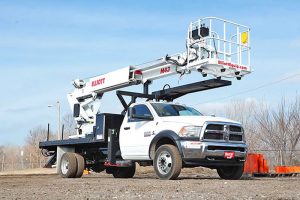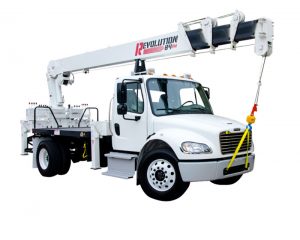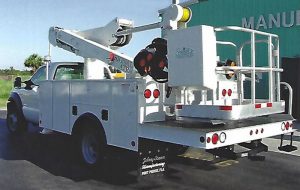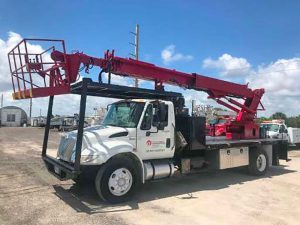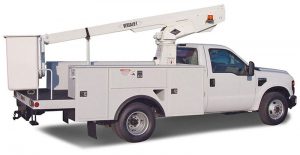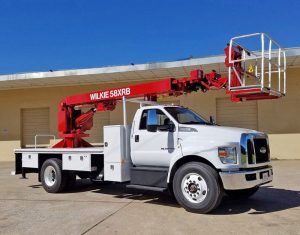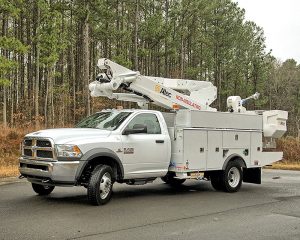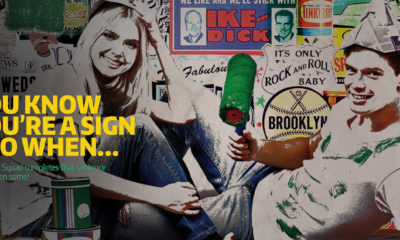IN MANY WAYS, signshops tend to be specialists. Maybe you wrap and letter vehicles, or perhaps create point-of-purchase and real-estate signs. In many cases, lots of sign companies leave larger jobs on the table because the shops are not equipped to properly install the sign. Digging a hole and dropping in a post is one thing, but hanging one from the side of a building 50 ft. up is another. If this is the case with your shop, then you may want to consider a crane truck.
Cranes allow the installer to stand relatively firmly on an elevated platform while still being able to work freely with both hands. Depending upon the manufacturer, a myriad of options also makes life easier for the installers. For example, there are options for boom height that can dictate what type of structures your shop can handle. If you work mainly with strip malls, why invest in a super long boom? Installers need power tools and sometimes welding equipment at height. Some companies offer 110 V service in the basket and even welding terminals. Another option to consider is a truck that features a winch. This can save trips to the ground for supplies and can greatly aid in lifting assemblies into position.
Safety First
So all of this is great, but there is another elephant in the room when it comes to owning and operating a crane: safety. Hoisting people and materials several stories into the sky can present dangers to both the folks in the basket as well as passersby on the ground. What happens if that last screw is just slightly out of reach? No problem, I’ll just step up on the side of the … splat! Seriously, accidents can and do happen, and if you deploy a crane truck, then it is up to you to ensure everyone’s safety.
The first way to address safety is to educate the operators. Beyond just throwing the manual at them and saying figure it out, specific classes potentially leading to certification on the operation of the crane truck must be provided. According to the National Commission for the Certification of Crane Operators’ (NCCCO) website, “Operators of most cranes above 2,000 lb. capacity when used in construction will need to be either certified by an accredited crane operator testing organization, such as the NCCCO, or qualified through an audited employer program.” Also, operators should perform operational inspections to ensure everything is functioning properly before going out on every job. Little things like a hydraulic line leaking a bit or a cable that’s slightly frayed but seems to be okay cannot be tolerated. Going back to our installation example above, the operator/installer must keep both feet firmly planted on the floor of the basket. Don’t even think about a step stool.
This means you need to factor in the cost of additional safety equipment that should be onboard at all times. Safety cones ought to be used to warn motorists and pedestrians of the presence of the crane. If the installers will be working with anything above their heads, then they will need hard hats. A fire extinguisher should, of course, be available. If the truck is parked on a non-level surface, then the tires must be chocked.
Probably one of the most important safety items is a fall-protection system. This is not as simple as a safety belt latched onto a rail of the bucket. It must ensure that a fall will not allow the person to hit any of the fittings on the crane or truck. Most of the crane companies can provide a system or help in locating one.
Advertisement
Crane trucks are a great way to add additional revenue to your shop by not only keeping installations in-house, but by helping you tap into markets that may have otherwise been out of reach, so to speak. Whatever you do, make sure your people are properly trained and equipped to keep it safe for everyone.
PHOTO GALLERY ( 7 IMAGES)



 Tip Sheet4 days ago
Tip Sheet4 days ago
 Business Management2 weeks ago
Business Management2 weeks ago
 Women in Signs2 weeks ago
Women in Signs2 weeks ago
 Real Deal5 days ago
Real Deal5 days ago
 Benchmarks1 day ago
Benchmarks1 day ago
 Editor's Note1 week ago
Editor's Note1 week ago
 Line Time2 weeks ago
Line Time2 weeks ago
 Product Buying + Technology1 week ago
Product Buying + Technology1 week ago